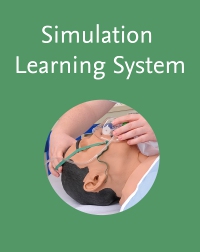
Simulation Learning System for LPN/LVN (User Guide and Access Code), 1st Edition
Simulations - SLS - Access Card

The Simulation Learning System (SLS) for LPN is an online toolkit designed to help you effectively incorporate simulation into your curriculum. This comprehensive product offers 35 simulation scenarios that correspond to Elsevier’s market leading texts in each core nursing discipline: Nursing Fundamentals, Medical-Surgical Nursing, Pediatric Nursing, OB-Peds Nursing, and Psychiatric Mental Health Nursing. It also offers detailed instructions for preparation and implementation of the simulation experience, debriefing questions that encourage critical thinking, and learning resources to reinforce comprehension. If your program is looking to enhance the clinical decision-making skills of students at all levels — reinforce their classroom knowledge base, bridge the gap between lecture and clinicals, and offer remediation — then look no further than Elsevier’s Simulation Learning System (SLS) for LPN.
-
- 35 simulation scenarios correspond to Elsevier’s market leading texts in each core nursing discipline:
- 13 scenarios for Medical-Surgical Nursing
- 4 scenarios for OB Nursing
- 5 scenarios for Pediatric Nursing
- 10 scenarios for Nursing Fundamentals
- 3 scenarios for Psychiatric Nursing
- Robust EHR platform (powered by SimChart) houses the skills drills and patient records for simulation.
- More than 180 skills drills give students additional opportunities to practice and master core skills prior to simulation. Each drill includes documentation exercises connected with the skill, so they’ll get more experience working within the EHR.
- Implementation module for each scenario provides facilitators with a framework to successfully incorporate simulation into their curricula with step-by-step instructions for preparation, implementation, debriefing, and remediation. Each scenario is presented in four sections according to the phases of the simulation experience:
- PREPARATION SECTION outlines the scenario overview and purpose, performance objectives for students, significant patient data, and guidelines for preparation and implementation of the scenario. A packet of printable resources to be used prior to and during the simulation scenario includes:
- Staging instructions with detailed outlines to guide you through preparing the setting for each scenario
- Algorithm quick card featuring a graphically represented protocol with defined guidelines to follow as the student progresses through a simulation scenario
- Performance checklist providing the facilitator with a comprehensive and detailed list of expected skills to be performed by the student based on the QSEN competency domains, in a format that allows for evaluation during the scenario
- Patient report supplied via script (either instructor-read or student-read) allowing the facilitator to choose how the student will receive patient information prior to simulation and encourages a realistic transfer of patient information for the nurse who will next assume responsibility of care
- Patient response guide featuring scripted comments and questions for the facilitator to use on behalf of the patient during the scenario; guides the facilitator in encouraging realistic nurse-patient communication in the simulated experience
- Additional participant response guide giving background information for additional roles (e.g.,family member, physician, nurse assistant) along with specific comments and questions that they can use to simulate realistic interactions and prompt nursing action
- Participant role badges and patient identity band
- Observer evaluation rubric based on the NCLEX-Examination categories of client needs
- SCENARIO SECTION describes the physiologic phases for the patient scenario as well as instructions for initiating the simulation experience. It also includes:
- Clinical decision support resources (such as Mosby’s Nursing Consult Student Edition) in the EHR that mimic the resources students will use in practice
- DEBRIEFING SECTION provides the facilitator with instructions for leading debriefing and well as specific discussion questions and topics. Specifically, it includes:
- Debriefing/reflection guide for a structured and successful debriefing session
- Guided discussion questions that facilitate collaborative evaluation and analysis of student performance, with corresponding remediation resources from your Elsevier text
- Animations, skills videos, and audio clips for reviewing physiologic processes and nursing procedures
- Answers and rationales, key points, page references, and reading assignments from the textbook
- LEARNING RESOURCES include reading assignments from the text, pre-simulation exercises and quizzes, post-simulation exercises and quizzes, and multimedia resources to reinforce simulation learning and help develop students’ critical reasoning.

 as described in our
as described in our 